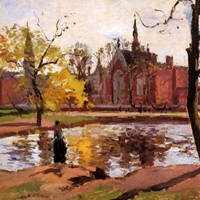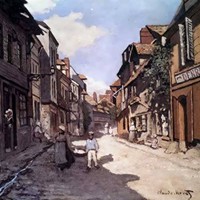|
|
The artists work willingly in the Louvre,
studying examples of painting. Manet, Fantin-Latour and Whistler
meet in these rooms, or in a free studio which has been opened on the
Quai des Orfevres, the Academie Suisse, where they may find models without
having to submit to correction. Fantin-Latour came from the studio of
Lecoq de Boisbaudran, which encouraged its pupils to exercise their visual
memory and seek in real life models for movement.
In 1857, Manet visits Delacroix to ask permission to copy "Dante
and Virgil in Hell," in the National Museum. But he is particularly
inspired by the Venetians. "Little by little", notes Antonin
Proust, "he would have suppressed the half-tones. The immediate passage
from shade to light was his constant quest. In Titian, the luminous shadows
enthused him." His copies are already transpositions where he applies
himself to defining structures without lingering over useless nuances.
However, the signs of novelty, the antidotes, multiplied. In 1856 the
engraver Braquemond obtains Japanese Ukiyo-e
woodblock prints by Hokusai
(1760-1849) and soon opens a boutique in the rue de Rivoli with objects
from the Far East, where the difference between Chinese and Japanese art
can be learned. In 1857 Whistler goes to Manchester where fourteen Velazquez,
genuine or believed real, are shown. The Louvre is not well endowed with
the works of this painter; Manet has already copied one attributed to
him. Shortly afterwards a Spanish ballet composed of singers and dancers
arrives in Paris and he finds living inspiration in them. On a trip to
Holland he copies Rembrandt.
In 1859 all the young painters submit their works for the Paris
Salon (which is held every two years). Manet's painting, "The
Absinthe Drinker," is rejected despite the support of Delacroix.
Fantin-Latour and Whistler, and even an acknowledged painter like Millet,
are no more fortunate. Only Pissarro is accepted in the wake of Corot.
The jury was so manifestly unjust that the painter Francois Bonvin, well-disposed
towards the young, decides to exhibit some of the rejected paintings in
his own studio. Courbet visits the studio and is very impressed by the
works of Whistler and Fantin-Latour, whom he invites to come and see him.
Claude Monet
A young painter, Claude Monet, has just
arrived in Paris to see the Salon of 1859. He has been a pupil in Le Havre,
after a wild and vagabond childhood. Clever at drawing,
he has made something of a name for himself by caricaturing local notables,
until he becomes acquainted with Eugene
Boudin. The latter has advised him politely to broaden the scope of
his vision and discover the wonders of nature, the sky and the sea.
Boudin was simplicity and sensitiveness
itself - he submitted humbly to his impressions which brought him so much
pleasure that he set about translating them with an attention to detail
that sometimes led to a whittling down of the subject, but which always
kept a freshness and a remarkable purity. At first a frame-maker, he had
sold materials to passing painters, notably Troyon and Millet. He took
their advice and kept in touch with them. A city scholarship had allowed
him to spend some time in Paris, but that had in no way changed his manner
of working directly in the open air, according to elementary principles
which he enunciated with clarity and good sense, and which could be summed
up thus: submit to nature, follow one's first impression which is always
the right one.
Monet was soon captivated by the simplicity
and good nature of the older man and felt singularly enriched in following
his advice. "It was as if a veil had been torn aside. I had grasped
what painting could be." Courbet, on a trip to Le Havre with his
friend Schanne, in his turn discovers Boudin's seascapes. He becomes acquainted
with the painter, who takes him to Saint-Simeon farm at Honfleur to admire
the magnificent panorama of the Seine estuary. There they meet Baudelaire
who also is enthusiastic about Boudin's work and adds a commentary to
his Salon of 1859 to praise the" meteorological beauties" of
Boudin's pastel work.
At the Salon a wide-eyed Monet discovers
the works of Daubigny, Corot, Rousseau and other giants of French
painting. He finds the lessons of the Fine Arts School repugnant and
prefers the Academie Suisse, where he meets Pissarro. He frequents the
Brasserie des Martyrs and gradually becomes a part of the world of young
painters. At the beginning of 1860 a private exhibition is opened in the
Boulevard des Italiens of works by Delacroix, Corot, Courbet and the Barbizon
painters, loaned by private collectors. It is a valuable example to all.
As soon as the weather permits, Monet leaves for Champigny-sur-Marne to
work in the open air. Pissarro also begins working on the outskirts of
Paris. At the Academie Suisse he has met two newcomers, Cezanne and Guillaumin.
The former, having studied law at Aix, has succeeded in joining his childhood
friend Emile Zola in Paris and gets down very conscientiously to the work
of preparing for his entry to the Fine Arts School. He is to be seen at
the Academy every morning from six until eleven, shy and lonely, but remarkable
for his determination and his vigorous execution. However, he fails to
gain entry to the school and leaves discouraged to return to Aix and enter
the family bank. Monet, for his part, is called up for military service.
Having refused his family's offer to buy him out providing he returns
to Le Havre, he leaves at his own request for Algeria. "You cannot
imagine", he says one day, "how much I learned there and how
my vision benefited. The impression of light and colours that I got down
there could only be realised later, but the seeds of my future research
were there." For more about the Impressionists attitude to light
and colour, see: Characteristics
of Impressionist Painting 1870-1910.
In 1861, Delacroix completes the frescoes of Saint-Sulpice in which he
uses big, separated strokes of the brush, which from a distance produce
the effect of melting into one and give more strength and freshness to
the fresco colours that always are a little dull. Fantin-Latour, who already
has a considerable command of grey colours, comes to admire Delacroix's
hatched nuances. Manet, on the other hand, leans towards painting of contrasts.
At the Salon he exhibits the double portrait of his parents and the first
of his Spanish themes, "The Guitarist." This time he wins honourable
mention. His friendship with Baudelaire, whom he met at the house of Commandant
Lejosne, becomes very close. It shows itself in concrete form in several
ways: inspiration of the prose poem "The Rope", drawn from an
incident in Manet's studio (the suicide of a youngster who had served
as a model for "Child with Cherries"); and the quatrain written
by Baudelaire under the portrait of Lola de Valence. In fact the whole
of Manet's work in these years is projected in Baudelaire's writing. While
the poet proclaims modernity of vision and substitution of present elements
for the conventions of fiction, he quickly finds an echo, and what an
echo, in Manet's painting. A direct affinity, an almost physical kinship
is established between the writer and the painter, while Baudelaire's
admiration for Delacroix remains on a purely intellectual level and the
presence of Baudelaire in a work by Courbet remains accidental.
NEXT: (3) The
Impressionist Edouard Manet.
Note: For details of the art critic who
gave the Impressionists their name, please see: Louis
Leroy (1812-1885).
Acknowledgements:
We gratefully acknowledge the use of an excerpt from Impressionism,
by Jacques Lassaigne (1966).
|



